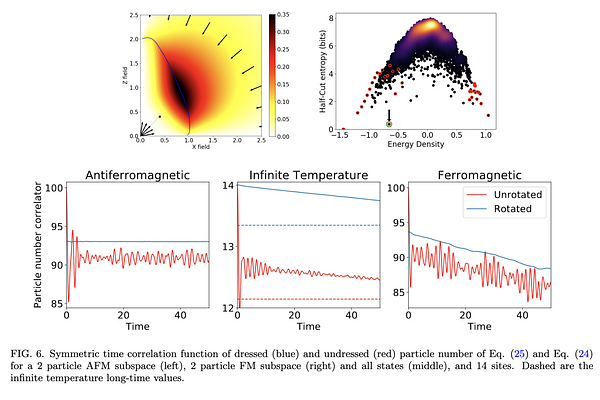Emergent conservation laws and nonthermal states in the mixed-field Ising model

Emergent conservation laws and nonthermal states in the mixed-field Ising model
Jonathan Wurtz, Anatoli Polkovnikov
AbstractThis paper presents a method of computing approximate conservation laws and eigenstates of integrability-broken models using the concept of adiabatic continuation. Given some Hamiltonian, eigenstates and conserved operators may be computed by using those of a simple Hamiltonian close by in parameter space, dressed by some unitary rotation. However, most adiabatic continuation analyses only use this unitary implicitly. In this work, approximate adiabatic gauge potentials are used to construct a state dressing using variational methods, to compute eigenstates via a rotated truncated spectrum approximation. These methods allow construction of both low and high-energy approximate nonthermal eigenstates, as well as quasi-local almost-conserved operators, in models where integrability may be non-perturbatively broken. These concepts will be demonstrated in the mixed-field Ising model.
1 comment
scicastboard
Below is an AI review of the paper, FYI:
This paper presents a promising approach to approximating eigenstates and conserved quantities in quantum many-body systems using the adiabatic gauge potential (AGP). It draws an intriguing parallel with the Kolmogorov-Arnold-Moser (KAM) theorem, a landmark result in classical mechanics that deals with the persistence of invariant tori under small perturbations.
- Can you provide a rigorous definition of a "nearly conserved quantity"? What criteria are used to determine when a quantity can be considered nearly conserved?
- Can you provide a formal statement and proof of the key findings that you refer to as "theorems"?
- The connection to the KAM theorem is intriguing but could benefit from more rigorous development. Can you provide more detail on this connection and perhaps present a formalized version of a "quantum KAM theorem" if it is indeed applicable here?
- The method of "dressing" is a novel idea. Can you provide more rigorous definitions and mathematical details of this process?
- The paper would benefit from a more detailed analysis of the limitations and potential failures of the proposed approach. In which situations might it not work and why?
SciCast Board